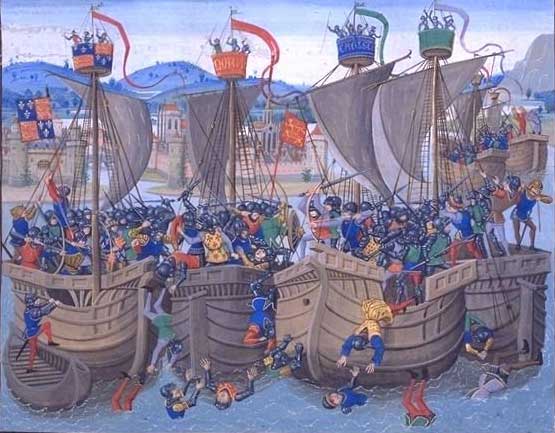
Ships were at times used for direct warfare, not just for military transport. Naval warfare was most important in the Mediterranean; both Muslim and Christian kingdoms kept naval fleets of galleys. Northern Europe’s foray into naval warfare was delayed, although merchant vessels began carrying crossbows to defend against piracy. Piracy was the first reason to create military vessels to support merchant shipping, more than foreign warfare.
In the Mediterranean Sea, Egypt, Constantinople, Venice, Genoa, and other regional powers maintained galley fleets with both rowing benches and a lateen sail. The galleys were armed with a platform that ran the length of the vessel—so that men could pass easily from end to end—and with freestanding pavises (shields) and crossbows. Some had a forecastle, perhaps armed with small catapult weapons.
A naval battle typically began with distance shooting. Crossbows were increasingly the largest part of naval battles. As the ships rowed closer, each crew would try to board and master the other. Ships usually had a boarding platform of some kind, something that stuck out and could be touched to the other ship. They also threw grappling hooks out, attached to iron chains. Poleaxes could reach out to cut the enemy’s rigging. Some crews threw soap on the other ship’s decks to make fighters slip. Others threw lime at the enemy to blind them. Most devastating, those who had access to its formula flung Greek fire, catching the enemy’s ship on fire. Nothing but ammonia, in the form of stale urine, could douse Greek fire. There was a great deal of hand combat, although crews were lightly armed. Plate armor had no place at sea, but hardened leather or light chainmail could help in close combat.
During the 14th century, the countries of the North Atlantic built up their stock of fighting ships. France and England both acquired some galleys. During the Hundred Years’ War, French galleys harassed English shipping and attacked English ports and English-owned ports in France, such as Bordeaux. English galleys, often hired as Spanish or Italian mercenaries, tried to defend shipping. Germany’s Hanseatic League was often armed, and there was an order of oceangoing Crusaders in Germany to protect shipping against infidel attacks.
Further Reading Fagan, Brian. Fish on Friday. New York: Basic Books, 2006. Grohskopf, Bernice. The Treasure of Sutton Hoo: Ship-Burial for an Anglo-Saxon King. New York: Atheneum, 1970. Hattendorf, John B., and Richard W. Unger. War at Sea in the Middle Ages and the Renaissance. Woodbridge, UK: Boydell Press, 2003 Haws, Duncan. Ships and the Sea: A Chronological Review. New York: Thomas Y. Crowell, 1975. Haywood, John. Dark Age Naval Power: A Reassessment of Frankish and Anglo- Saxon Seafaring Activity. Norfolk, UK: Anglo-Saxon Books, 1999. Hutchinson, Gillian. Medieval Ships and Shipping. London: Cassell, 1997. Konstam, Angus. The History of Pirates. Guilford, CT: Lyons Press, 1999. Lewis, Archibald R. European Naval and Maritime History, 300–1500. Bloomington: Indiana University Press, 1985. Meisel, Tony. To the Sea: Sagas of Survival and Tales of Epic Challenge on the Seven Seas. New York: Black Dog and Leventhal Publishers, 2000. Milne, Gustav. The Port of Medieval London. Stroud, UK: Tempus Publishing, 2006. Morrison, John. Age of the Galley: Mediterranean Vessels since Pre-Classical Times. London: Conway Maritime Press, 2004. Pryor, John H. Geography, Technology, and War: Studies in the Maritime History of the Mediterranean, 649–1571. Cambridge: Cambridge University Press, 1992. Rose, Susan. Medieval Naval Warfare 1000–1500. New York: Routledge, 2001. Unger, Richard W., and Robert Gardiner. Cogs, Caravels, and Galleons: The Sailing Ship 1000–1650. Seacaucus, NJ: Chartwell Books, 2000. Woodman, Richard. The History of the Ship. London: Conway Maritime Press, 1997.